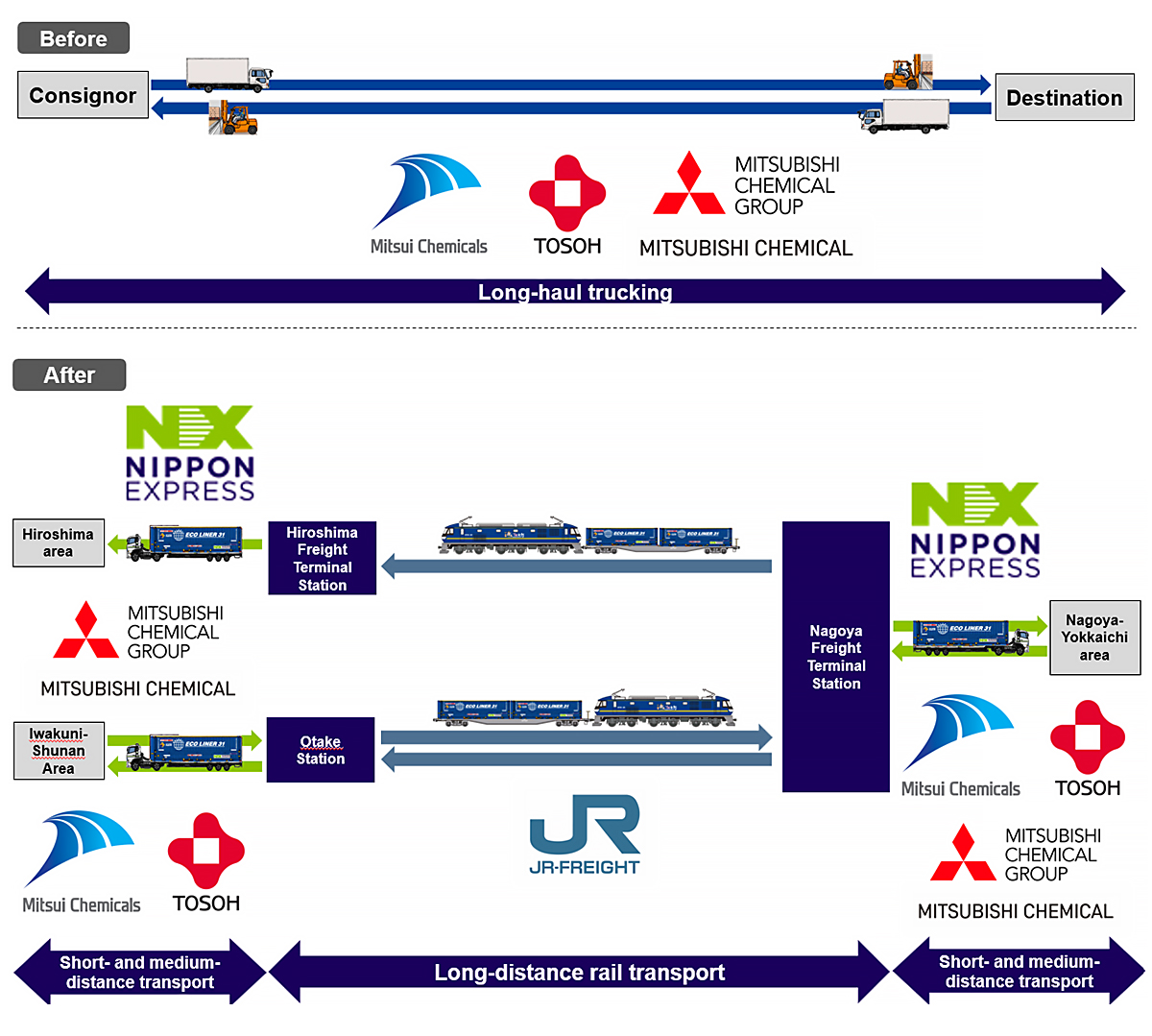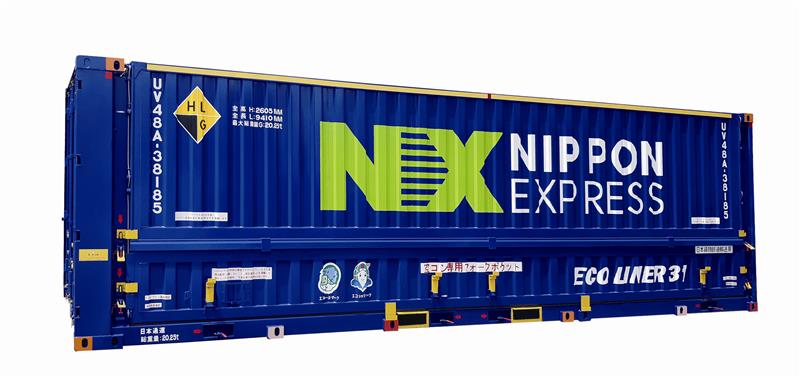Industry Group Launches Collaborative Logistics Demonstration Test Using Rail Transport in Tokai and Chugoku Regions in Effort to Solve Logistics Issues in Chemical Industry
Standardizing on 31-foot containers
2025.07.29
Mitsui Chemicals, Inc.
The Chemicals Working Group (Chairman: Professor YANO Yuji, Ryutsu Keizai University) of the Physical Internet Realization Council, which is led by the Ministry of Economy, Trade and Industry (METI) and the Ministry of Land, Infrastructure, Transport and Tourism (MLIT), will run a demonstration test from August 2025 to January 2026 with the aim of realizing collaborative logistics via rail transport in the Tokai and Chugoku region.
The Chemicals Working Group currently includes 82 members (81 companies and 1 university), most of them consignors and logistics providers, and sees participation from the Japan Chemical Industry Association, the Japan Petrochemical Industry Association, and several relevant divisions from METI and MLIT, among other bodies. Mitsui Chemicals, Inc., Mitsubishi Chemical Corporation, Tosoh Corporation and Toray Industries, Inc. serve as the Group’s joint secretariat.
For further information, please see the following materials.
Physical Internet Realization Council
Chemicals Working Group
Industry Group Launches Collaborative Logistics Demonstration Test Using Rail Transport in Tokai and Chugoku Regions in Effort to Solve Logistics Issues in Chemical Industry
Standardizing on 31-foot containers
The Chemicals Working Group*1 of the Physical Internet Realization Council*2, which is led by the Ministry of Economy, Trade and Industry (METI) and the Ministry of Land, Infrastructure, Transport and Tourism (MLIT), will conduct a demonstration test to realize collaborative logistics via rail transport in the Tokai and Chugoku regions. Spanning August 2025 to January 2026, the demonstration test will use freight stations between Nagoya, Aichi and Otake, Hiroshima as relay points in an effort to improve the transport capacity of chemicals through a modal shift. The ultimate goals of the test are to realize collaborative logistics in the Tokai and Chugoku regions, and to establish a standard scheme for joint rail transport that can be deployed throughout Japan.
 Scheme overview
Scheme overview
Challenges in chemical transportation
As symbolized by the "2024 Logistics Problem," a lack of transportation capacity is a serious issue for the chemical industry. It is estimated that by 2030, Japan will face a 34% shortfall in commercial truck transport capacity.*3
Due to the unique characteristics of the cargo involved, such as its physical properties, packaging form, and weight, chemical logistics requires a wide variety of transport methods and conditions, and there are limitations to what individual companies can do to resolve these issues. The Chemicals Working Group previously conducted a demonstration test of collaborative logistics using truck transport between Yokkaichi and Ichihara in FY2024, which resulted in a 20% improvement in truck loading rate and a 28% reduction in CO2 emissions.
Now, for fiscal 2025, the Group has decided to expand the area in which collaborative logistics are run and promote changes in transportation modes by conducting a new demonstration test. The new test will center on collaborative logistics using rail transport based on transportation data from companies participating in the Rail Transport Subcommittee.
Overview of the demonstration test
Compared to the commonly used 12-foot containers, 31-foot containers have higher loading efficiency and can carry a larger amount of cargo per container. However, this setup is difficult to operate efficiently with a single shipper due to the fact that – among other issues – there is typically a need to carry more cargo from a factory to a consumption area than in the other direction.
In this new demonstration test, the aim is to establish a standard scheme for collaborative logistics using rail transport for optimal transportation by having multiple shippers jointly operate dedicated 31-foot containers in the Tokai and Chugoku regions, which have high transport volumes. The scheme will use Nagoya Freight Terminal Station, Hiroshima Freight Terminal Station, and Otake Station as departure and arrival points.
Participants in the demonstration experiment
Shippers:Mitsubishi Chemical, Tosoh, Mitsui Chemicals
Logistics companies:JR Freight, Nippon Express
Key details
- The project is scheduled to run from August 2025 to January 2026.
- Shipments from Mitsubishi Chemical and Tosoh will be transported to the Chugoku region via Nagoya Freight Terminal Station, while shipments from Mitsui Chemicals will be transported to the Tokai region via Otake Station.
- The project is intended to identify the various applications and issues required for utilizing 31-foot containers, allowing participants in the Group to compile these applications and issues into a standard scheme for implementation.
 31-foot container
31-foot container
Expected results and future plans
This demonstration test is expected to achieve a modal shift away from truck transport by single shippers and toward a rail transport setup in which dedicated containers are used by multiple shippers. In addition to reducing greenhouse gas emissions, improving punctuality, and complying with business continuity planning requirements through two-way shipping, this change is expected to reduce driver working hours and the number of long-distance trucks used, as well as create surplus truck transport capacity that can then be utilized as required.
Going forward, the Chemicals Working Group will continue to consider ways to improve logistics efficiency, such as a modal shift in truck transport for medium- to long-distance transport, logistics cooperation for the likes of area collection and delivery, standardization of materials and codes, and going paperless.
*1 Physical Internet Realization Council
An organization established by METI and MLIT in October 2021 to formulate a roadmap for achieving a physical internet in Japan. https://www.meti.go.jp/shingikai/mono_info_service/physical_internet/index.html (Japanese only)
*2 Chemicals Working Group
Chairman: Professor YANO Yuji, Ryutsu Keizai University (Dean, Faculty of Distribution and Logistics Systems; President, Japan Logistics Society)
Secretariat: Mitsubishi Chemical Group, Mitsui Chemicals, Tosoh, Toray
Participants include 82 organizations (81 companies and 1 university, as of the end of June 2025), mainly shippers and logistics companies, as well as the Japan Chemical Industry Association, the Japan Petrochemical Industry Association, and relevant departments of METI and MLIT.
Announced on December 20, 2023: Voluntary action plan to streamline logistics and improve productivity for chemical products.
https://www.cas.go.jp/jp/seisaku/buturyu_kakushin/jk_pdf/28.pdf (Japanese only)
*3 Cabinet Secretariat, Ministerial Conference on Innovation in Japan's Logistics, "Key Points of Policy Package for Innovation in Logistics" (Japanese only)
■ References
- June 25, 2025: Physical Internet Realization Council’s Chemicals Working Group Reported the FY 2025 Action Policy
https://jp.mitsuichemicals.com/content/dam/mitsuichemicals/sites/mci/documents/release/2025/250625e.pdf
- December 23, 2024: Physical Internet Realization Council’s Chemicals Working Group Runs Demonstration Test to Find Effects of Collaborative Logistics
https://jp.mitsuichemicals.com/content/dam/mitsuichemicals/sites/mci/documents/release/2024/241223_1e.pdf
- June 11, 2024: “Physical Internet Realization Council’s Chemicals Working Group to Conduct Demonstration Test for Collaborative Logistics in the Kanto–Tokai Region”
https://jp.mitsuichemicals.com/content/dam/mitsuichemicals/sites/mci/documents/release/2024/240611.pdf (Japanese only)
- June 13, 2023: “Establishment of a Chemicals Working Group in the Physical Internet Realization Council”
https://jp.mitsuichemicals.com/content/dam/mitsuichemicals/sites/mci/documents/release/2023/230613e.pdf

